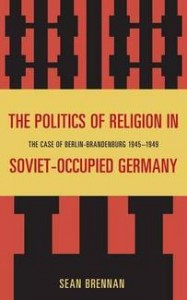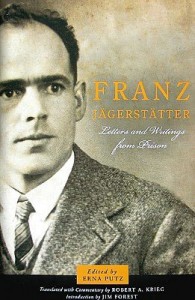Contemporary Church History Quarterly
Volume 30, Number 3 (Fall 2024)
Review of Klara Kardos, The Auschwitz Journal: A Catholic Story from the Camps, trans. Fr. Julius D. Leloczky, O.Cist. (Paraclete Press, 2020). 144 Pp.
By Beth A. Griech-Polelle, Pacific Lutheran University
In June 1944, a young Hungarian woman, born in 1920, received the order that she had to vacate her apartment, taking with her only the things she could carry. She noted in her account, “My packing was very simple indeed: just the bare minimum of the most needed items. As we were leaving, the apartments were sealed… And in our room was hanging on the wall – I left it there deliberately – the crucifix.” (33-34) Until the last portion of the sentence is reached, the reader might assume this is going to be an account of one of the millions of Jewish victims of Nazi horrors. Indeed, the young Hungarian woman, Klara Kardos, was born into a Jewish family although her mother had converted to Catholicism before Klara was born, Klara’s parents were divorced, and Klara had been baptized as an infant into the Catholic faith. For many non-experts, Klara’s deportation to a ghetto in Szeged, then her internment in Auschwitz concentration camp, where her forearm received the tattoo, might come as a shock. How could Klara, who identified wholeheartedly with her Catholic identity, end up in a Nazi death camp as a Jew? Of course, for the experts this is perhaps not as puzzling, as Klara and her extended family fell under the Nazi racial classification system as racially Jewish. But Klara’s account of her experiences during the Holocaust are not the usual recounting. To Klara, her suffering (of which she speaks very little) was part of her Catholic faith. She understood, as a well-educated young woman, that she was persecuted for an identity to which she did not ascribe, and that many of the Jewish inmates did not feel a connection to her since she had never been a practicing Jew. The entire, relatively short account that Klara provides for her readers is focused, not on the countless indignities and the unimaginable horrors recounted by Holocaust survivors such as Primo Levi, but instead on how her memories of she fought to preserve and persevere in her faith. For some readers, this account might be somewhat disappointing. It does not seek to dwell on the nightmarish world created by the Nazis. Instead, she wants her readers to focus on how she relied on her Catholic faith as a way to sustain the human spirit in the midst of untold tragedies.
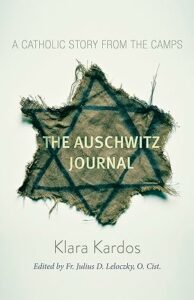 Much like Viktor Frankl’s Man’s Search for Meaning, in which Frankl made a conscious decision to fight to retain his humanity against all odds, Klara Kardos’ story features a similar decision. In Kardos’ case, though, her prayer life and her way of framing her persecution allowed her to detach herself from the day-to-day horrors she was experiencing. When Kardos was deported from the Szeged ghetto to Auschwitz, her spiritual director (a priest not named in full in the account) wrote of her walking to the deportation train as a “deportee of heroic spirit… with a triumphant smile on her face for the road of sufferings. Will she ever return to Szeged? Only God can say. We can only hope. But her heroic spirit that was shining from her soul showed the world that the soul, even in a body trampled underfoot, in the midst of ignominy, can be victorious over her oppressors…” (42). Kardos humbly remarks that the priest’s words were very idealistic, but she also confirms that the essence of his words describing her departure were true.
Much like Viktor Frankl’s Man’s Search for Meaning, in which Frankl made a conscious decision to fight to retain his humanity against all odds, Klara Kardos’ story features a similar decision. In Kardos’ case, though, her prayer life and her way of framing her persecution allowed her to detach herself from the day-to-day horrors she was experiencing. When Kardos was deported from the Szeged ghetto to Auschwitz, her spiritual director (a priest not named in full in the account) wrote of her walking to the deportation train as a “deportee of heroic spirit… with a triumphant smile on her face for the road of sufferings. Will she ever return to Szeged? Only God can say. We can only hope. But her heroic spirit that was shining from her soul showed the world that the soul, even in a body trampled underfoot, in the midst of ignominy, can be victorious over her oppressors…” (42). Kardos humbly remarks that the priest’s words were very idealistic, but she also confirms that the essence of his words describing her departure were true.
The train journey to Auschwitz took three long, excruciatingly hot days in June 1944. Kardos describes the fear, the rumors, and the “absurd” (44) movement of people in her train carriage, putting on all of their best clothes. Not knowing where they were being taken to, many hoped that, if they dressed up in their best outfits, they would make a strong impression. In contrast to their actions, Kardos relates how she took out the pictures of her parents and younger sister and ripped the photos up, letting them out slip through the train carriage’s ventilation slit. She explains that she did not want “sacrilegious” hands to touch her family photos. Once she had disposed of her precious family photos, she placed her rosary around her neck and waited for what might happen next. (45-46)
She arrived at Auschwitz on 28 June 1944. Kardos rejects delving into the details of de-training, not because she does not recall the bad memories, but because, she says, “I do not consider it worth doing.” (49) Like Frankl’s earlier work, Kardos asserts that she is most interested in writing how “we tried to remain human in the midst of inhuman circumstances.” (51) She chooses to focus on the unexpected times she encountered expressions of love, although that does not prevent her from also detailing at least some of the dehumanizing procedures experienced by those selected for work in the camp. She also writes of the hastily prepared barracks for the Hungarian deportees, the last large Jewish community in Europe to be deported. Kardos describes the summer thunderstorms with rain pouring in through the roof, soaking everyone inside. No beds, cots, or planks to sleep on were available there. During one particular drenching nighttime rainstorm, Kardos recalled how several of the women took their shared blanket, made a tent over their heads and stood reciting the rosary prayer in the wet darkness. Kardos recalls how more women joined in. On the first Sunday in Auschwitz, Kardos relates how, as a young child, she had memorized the Latin text of the ordinary mass, and the Christian women in the barracks held a version of the mass. The end of the service concluded with the recitation of religious Hungarian poems with Kardos writing, “That’s the way the Christian community of Auschwitz celebrates the Lord’s Day…” (72) Of course, readers should remind themselves of two important pieces of context: the first, that Catholic masses at this time were always said in Latin, and the Hungarian-language poems were an expression of a specific community; the second, that, to the Nazi regime and its collaborators, Klara Kardos was not considered to be a Christian at all. Hence, she is in Auschwitz because she has been placed into the racial category of being Jewish, not because of her Catholic faith.
Kardos writes of the changes that she experienced in her spiritual life at Auschwitz. She used to meditate on texts of the Holy Mass during the long, drawn-out Appels (roll calls). She talks about “spiritual Communion”, meaning that spending time counseling other camp inmates, reciting poems by Catholic Hungarian authors, and participating in “cultural events” when inmates were restricted to their barracks was her way of practicing her faith in the absence of priests and the sacrament of the Eucharist. She also notes that she spent time trying to get to know the “real” Jews (79), although she recognizes that there was a wide abyss between those who were imprisoned in Auschwitz as “real” Jews versus “non-Aryan Christians.” No matter the divide, the Nazi regime worked to control all of the camp population. By July 1944, Kardos was selected along with ninety-nine other women to be moved to the “Czech camp”, Camp B2. While in Camp B2, Klara forms friendships with three other women, and she comments on how the barracks had furniture to sleep on and even water. Despite these “improved” conditions, starvation began to take its toll of most of the women, although Kardos would not indulge in fantasies about food with other inmates. Instead, she would separate from those conversations, stating that “the spirit, not the body, should enforce its rights!” (92) She reiterates this emphasis on the spiritual over physical reality when she describes how, at one point in the camp, sitting alone on her camp bunk, she experienced a visitation of her loved ones in her mind. (98) To Kardos, this experience was so intense that it served to confirm her core belief that the spirit can triumph over the limitations of physical reality. But physical reality was always lurking in the background, and Kardos contracted scarlet fever, landing her in the camp infirmary for a time.
Kardos used her time in the infirmary to increase her spiritual devotions, converting another ill inmate to Catholicism while interned there. After three months in Auschwitz, Kardos was once again selected to leave that particular Hell. Her first stop after Auschwitz was Bergen-Belsen, and after a few weeks in Bergen-Belsen, she was sent to work in an ammunition factory. In the factory, she mentions the 12-to-15 hour shifts that the inmates were forced to work. Despite the freezing cold and difficult circumstances, Kardos writes, “Trust in God and sheer willpower: they were our saviors. For the sake of God’s love, I just should not become sick! … This inner power of resistance was decisive. Whoever lost that also lost herself. But whoever clung to God possessed the greatest inner strength.” (117-118) Kardos worked in the ammunition factory from October 1944 to April 1945. Throughout the whirring machinery of the factory and the potentially dangerous conditions of working with explosives, Kardos reiterates her theme throughout the work: “To put it simply: we kept struggling to remain human!” (121)
Finally, on 14 April 1945, the first American troops entered the ammunition factory grounds. Kardos and one of her friends, Franci, walked to the nearby city to find a Catholic Church so that they could confess in order to attend Sunday mass and receive the Eucharist. Kardos was ill with a high fever at this time and, after finally getting to attend mass, she fainted. She was transported to the city hospital where Catholic nurses took care of her. While recovering her strength in the hospital, one of the nurses gave her a journal and a pen. Her first entry in the journal, which she kept with her for the rest of her life, read, “April 18, 1945, Wednesday. Magnificat! May this be the first word that I write down. …I have a Bible! I have a journal!—I have everything! With this I begin my little spiritual exercise in the sanatorium, if God helps me!” (137) Her journal recorded the suicide of Hitler, the death of Mussolini, and finally, her ability to make the journey back to Hungary. There Kardos worked through the slow and difficult process of reacclimatizing to middle-class standards of life. In her final pages of the book, Kardos reminds her readers that people kept asking for her personal story and she hoped that people who read the work would come to some degree of understanding of the “unbelievable, sweet paradox: the bliss, the happiness of suffering.” (143) Although most readers might never associate the words “bliss” or “happiness” with Auschwitz, to Kardos she firmly believed the her suffering was sanctified according to the principles of her Catholic faith.
Kardos’ account of her experiences provide insight into the life of a very religious and spiritual person who was constantly striving to understand what God wanted her to experience and how she might interpret those experiences. Her faith that her suffering served a larger purpose kept her mentally strong during unimaginable trials. Her faith eventually led her away from Communist Hungary to Austria and she passed the rest of her life translating religious works for the Catholic Church. Though a short account, it emanates with the power of Kardos’ religious fervor and opens up our world to an examination of how “non-Aryan Catholics” experienced the horrors of the Holocaust.

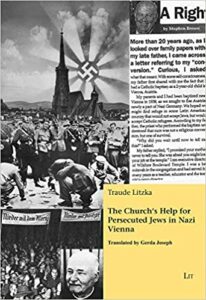 Despite the challenges of locating survivors and documents which would testify to the actions of the brave Catholic men and women engaged in rescue work, Litzka has assembled quite a roster of both individuals as well as orders of religious who decided that, despite the threat of arrest, interrogation, and imprisonment (or worse), their consciences would not allow them to remain inactive in the face of overwhelming discrimination and hardships. One such man who figures prominently throughout the book is the Jesuit priest, Ludger Born (born in Duisburg in 1897). Born was appointed as head of the “Aid Office for Non-Aryan Catholics” by Cardinal Theodor Innitzer in 1940 and for the next five years, Father Born worked assiduously to aid all those who needed help. He inherited his position from another priest, Father Georg Bichlmair, who had established the office and had staffed it primarily with dedicated women. Some of these women’s stories were later documented after the war by Father Born, providing some insight into both their identity and motivations. Out of the twenty-three employees, Father Born’s documentation focused on only five of the female workers. He attributed their dedication to their profound religiosity.
Despite the challenges of locating survivors and documents which would testify to the actions of the brave Catholic men and women engaged in rescue work, Litzka has assembled quite a roster of both individuals as well as orders of religious who decided that, despite the threat of arrest, interrogation, and imprisonment (or worse), their consciences would not allow them to remain inactive in the face of overwhelming discrimination and hardships. One such man who figures prominently throughout the book is the Jesuit priest, Ludger Born (born in Duisburg in 1897). Born was appointed as head of the “Aid Office for Non-Aryan Catholics” by Cardinal Theodor Innitzer in 1940 and for the next five years, Father Born worked assiduously to aid all those who needed help. He inherited his position from another priest, Father Georg Bichlmair, who had established the office and had staffed it primarily with dedicated women. Some of these women’s stories were later documented after the war by Father Born, providing some insight into both their identity and motivations. Out of the twenty-three employees, Father Born’s documentation focused on only five of the female workers. He attributed their dedication to their profound religiosity.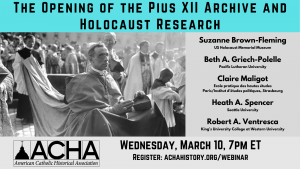 On March 10, 2021, the American Catholic Historical Association held a webinar entitled “The Opening of the Pius XI Archive and Holocaust Research.” Presenters included Suzanne Brown-Fleming, US Holocaust Memorial Museum: Beth A. Griech-Polelle, Pacific Lutheran University; Claire Maligot, Ecole pratique des hautes études, Paris, and Institut d’études politiques, Strasbourg; Heath A. Spencer, Seattle University; and Robert A. Ventresca, King’s University College at Western University.
On March 10, 2021, the American Catholic Historical Association held a webinar entitled “The Opening of the Pius XI Archive and Holocaust Research.” Presenters included Suzanne Brown-Fleming, US Holocaust Memorial Museum: Beth A. Griech-Polelle, Pacific Lutheran University; Claire Maligot, Ecole pratique des hautes études, Paris, and Institut d’études politiques, Strasbourg; Heath A. Spencer, Seattle University; and Robert A. Ventresca, King’s University College at Western University. After the war’s end, Father Fabisiak was working as a missionary in Bolivia. There, many people expressed their curiosity about “the Phenomenon,” or, as we call it, the Holocaust. The Polish priest served as a living witness to the events his parishioners had only heard about over radio broadcasts or had read in newspapers. And many of them were skeptical: could such atrocities have truly been committed by human beings? How could something so obscene as the Holocaust have been possible? This reluctance to accept what had happened inspired Fabisiak to write down his experiences—not out of hatred for the enemy, but as a way of showing readers what human beings are capable of doing to one another. Each chapter is very brief, written like a vignette, allowing readers to move easily from one terrifying experience to the next. All of this was written with the intent of documenting the truth of Father Fabisiak’s fate when he was in the hands of the Nazis.
After the war’s end, Father Fabisiak was working as a missionary in Bolivia. There, many people expressed their curiosity about “the Phenomenon,” or, as we call it, the Holocaust. The Polish priest served as a living witness to the events his parishioners had only heard about over radio broadcasts or had read in newspapers. And many of them were skeptical: could such atrocities have truly been committed by human beings? How could something so obscene as the Holocaust have been possible? This reluctance to accept what had happened inspired Fabisiak to write down his experiences—not out of hatred for the enemy, but as a way of showing readers what human beings are capable of doing to one another. Each chapter is very brief, written like a vignette, allowing readers to move easily from one terrifying experience to the next. All of this was written with the intent of documenting the truth of Father Fabisiak’s fate when he was in the hands of the Nazis. Hanebrink’s work has been influenced by the approach taken by Israeli historian Shulamit Volkov whose work on nineteenth-century Germany explained the rise of antisemitic language as part of a response to the many unsettling experiences caused by the late unification of Germany. No matter how quickly economic modernization, rapid urbanization, and cultural changes were dislocating people in Germany, Volkov argued that the use of antisemitic rhetoric and tropes about Jews were part of a “cultural code.” By addressing the “Jewish Question” an individual could then respond with solutions to the so-called problem. This often allowed many people to believe that the problems they were experiencing in their daily lives could be explained by one, all-powerful disruptor: the Jew. Hanebrink explores the use of the “Judeo-Bolshevik myth” over the course of different time periods and across various countries in Europe and the United States, allowing the reader to track how this destructive myth about Jews varied over the course of the twentieth century and to ponder why the myth continues to persist so powerfully into the twenty-first.
Hanebrink’s work has been influenced by the approach taken by Israeli historian Shulamit Volkov whose work on nineteenth-century Germany explained the rise of antisemitic language as part of a response to the many unsettling experiences caused by the late unification of Germany. No matter how quickly economic modernization, rapid urbanization, and cultural changes were dislocating people in Germany, Volkov argued that the use of antisemitic rhetoric and tropes about Jews were part of a “cultural code.” By addressing the “Jewish Question” an individual could then respond with solutions to the so-called problem. This often allowed many people to believe that the problems they were experiencing in their daily lives could be explained by one, all-powerful disruptor: the Jew. Hanebrink explores the use of the “Judeo-Bolshevik myth” over the course of different time periods and across various countries in Europe and the United States, allowing the reader to track how this destructive myth about Jews varied over the course of the twentieth century and to ponder why the myth continues to persist so powerfully into the twenty-first. Griech-Polelle begins with the rise of religious antisemitism—rooted in the concept of Jews as “Christ-killers’’—in the biblical accounts of Jesus’ arrest, death, and resurrection. With the emergence of Christianity came the belief that the Early Church was the “New Israel” which replaced the Jews as God’s chosen people (10-11). Tracing the loss of Jewish rights in the late Roman Empire, the author shows how the Codex Theodosianus began to impose restrictions on Jews and to generate the segregating language that would shape the medieval era. Through the period of the crusades and on into the Middle Ages, Griech-Polelle explains important incidents in the history of Jewish persecution, but beyond that, she endeavours to outline the way a particular kind of antisemitic language emerged in, for example, tropes like the Wandering Jew or the blood libel. A short section on Thomas Aquinas shows how he built on Augustine’s notion of the preservation of the Jews as a witness to the truth of both the Hebrew scriptures and the Christian gospels, adding that the Jews were people with souls that needed to be saved. “Somehow, Jews were to be converted voluntarily—despite the persecutions and horrendous depictions of Jews as being in league with the devil, desecrating the Host, and reenacting the crucifixion of Jesus” (20). This chapter on the history of religious antisemitism continues with the medieval expulsions of Jews from various European countries and follows the story through the Renaissance and Reformation, the emergence of a substantial Jewish community in Poland, and the impact of the Enlightenment, French Revolution, modern nationalism, and post-1848 reactionary politics. It closes with the persecution faced by Jews in Tsarist Russia.
Griech-Polelle begins with the rise of religious antisemitism—rooted in the concept of Jews as “Christ-killers’’—in the biblical accounts of Jesus’ arrest, death, and resurrection. With the emergence of Christianity came the belief that the Early Church was the “New Israel” which replaced the Jews as God’s chosen people (10-11). Tracing the loss of Jewish rights in the late Roman Empire, the author shows how the Codex Theodosianus began to impose restrictions on Jews and to generate the segregating language that would shape the medieval era. Through the period of the crusades and on into the Middle Ages, Griech-Polelle explains important incidents in the history of Jewish persecution, but beyond that, she endeavours to outline the way a particular kind of antisemitic language emerged in, for example, tropes like the Wandering Jew or the blood libel. A short section on Thomas Aquinas shows how he built on Augustine’s notion of the preservation of the Jews as a witness to the truth of both the Hebrew scriptures and the Christian gospels, adding that the Jews were people with souls that needed to be saved. “Somehow, Jews were to be converted voluntarily—despite the persecutions and horrendous depictions of Jews as being in league with the devil, desecrating the Host, and reenacting the crucifixion of Jesus” (20). This chapter on the history of religious antisemitism continues with the medieval expulsions of Jews from various European countries and follows the story through the Renaissance and Reformation, the emergence of a substantial Jewish community in Poland, and the impact of the Enlightenment, French Revolution, modern nationalism, and post-1848 reactionary politics. It closes with the persecution faced by Jews in Tsarist Russia.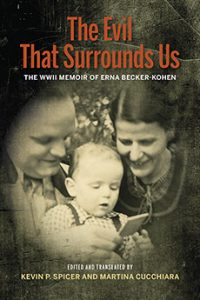 Erna’s first entry at Christmas 1937 begins with an announcement: she and her Catholic husband, Gustav, are expecting their first child in March. By this time, Hitler had been in power in Germany for four years. Erna and Gustav had married in 1931 while Erna was still Jewish and Gustav Catholic. As Spicer and Cucchiara note, the newlyweds could have had no idea then that their religious heritages would come to matter so very much to the outside world. In the early phases of Hitler’s chancellorship, Gustav continued working in an engineering company. His status as a pure Aryan accorded Erna a measure of protection. However, as the years of the Third Reich continued, Gustav and Erna would come to see that the so-called “privileged” status of their union was really no protection against an increasingly hostile German society. What adds yet another layer to this fascinating story is that Erna had converted to Roman Catholicism in 1936. She longed for community in the face of such social isolation and persecution and she took increasing solace in her Catholic faith.
Erna’s first entry at Christmas 1937 begins with an announcement: she and her Catholic husband, Gustav, are expecting their first child in March. By this time, Hitler had been in power in Germany for four years. Erna and Gustav had married in 1931 while Erna was still Jewish and Gustav Catholic. As Spicer and Cucchiara note, the newlyweds could have had no idea then that their religious heritages would come to matter so very much to the outside world. In the early phases of Hitler’s chancellorship, Gustav continued working in an engineering company. His status as a pure Aryan accorded Erna a measure of protection. However, as the years of the Third Reich continued, Gustav and Erna would come to see that the so-called “privileged” status of their union was really no protection against an increasingly hostile German society. What adds yet another layer to this fascinating story is that Erna had converted to Roman Catholicism in 1936. She longed for community in the face of such social isolation and persecution and she took increasing solace in her Catholic faith. Kornberg takes on both sides of the Pius War, questioning the various ways in which scholars have sought to either support Pius’s reactions to the Nazi regime or have tried to find fault with Pius’s response (or lack thereof). At the book’s outset, Kornberg asks the fundamental question that has frustrated both sides of the scholarly debate: “why was the pope unable to deal with radical evil?” (3) Kornberg argues that, in his view, the papacy of Pius XII was a moral failure out of “calculated acquiescence;” meaning that the pope willingly allowed Nazi atrocities to happen “because of his own priorities and responsibilities as head of the Roman Catholic Church” (8-9). Kornberg then tracks how Pius’s reputation drastically plummeted in the 1960s, in no small part to the wildly successful play by Rolf Hochhuth, Der Stellvertreter, (The Deputy) which depicted a cold, calculating Pius who sat silent in the face of Nazi crimes for “reasons of state” (16). With this incendiary play, debates raged: was Pius complicit with the Nazi regime due to his silence or was Hochhuth’s play no more than a deeply flawed portrayal of the Pope? Kornberg takes the reader through the play, the reactions and counter-reactions to it and links this to the role of Vatican II in further sealing the demise of Pius’s reputation. A new era was opening up for the Church under the leadership of the charismatic and charming Pope John XXIII and Kornberg dryly notes that in this new climate, “it was inevitable that Pius XII’s reputation would sink like a stone” (35). At issue here was the question of mission: what was the Catholic Church’s role? Was it to serve as a voice of morality to the world, was it to concern itself primarily with pastoral care, or was it to be a mixture of both of these? Raising these questions allows Kornberg to move on to his next chapter, addressing the options of Eugenio Pacelli and his role in the drafting of the Reichskonkordat.
Kornberg takes on both sides of the Pius War, questioning the various ways in which scholars have sought to either support Pius’s reactions to the Nazi regime or have tried to find fault with Pius’s response (or lack thereof). At the book’s outset, Kornberg asks the fundamental question that has frustrated both sides of the scholarly debate: “why was the pope unable to deal with radical evil?” (3) Kornberg argues that, in his view, the papacy of Pius XII was a moral failure out of “calculated acquiescence;” meaning that the pope willingly allowed Nazi atrocities to happen “because of his own priorities and responsibilities as head of the Roman Catholic Church” (8-9). Kornberg then tracks how Pius’s reputation drastically plummeted in the 1960s, in no small part to the wildly successful play by Rolf Hochhuth, Der Stellvertreter, (The Deputy) which depicted a cold, calculating Pius who sat silent in the face of Nazi crimes for “reasons of state” (16). With this incendiary play, debates raged: was Pius complicit with the Nazi regime due to his silence or was Hochhuth’s play no more than a deeply flawed portrayal of the Pope? Kornberg takes the reader through the play, the reactions and counter-reactions to it and links this to the role of Vatican II in further sealing the demise of Pius’s reputation. A new era was opening up for the Church under the leadership of the charismatic and charming Pope John XXIII and Kornberg dryly notes that in this new climate, “it was inevitable that Pius XII’s reputation would sink like a stone” (35). At issue here was the question of mission: what was the Catholic Church’s role? Was it to serve as a voice of morality to the world, was it to concern itself primarily with pastoral care, or was it to be a mixture of both of these? Raising these questions allows Kornberg to move on to his next chapter, addressing the options of Eugenio Pacelli and his role in the drafting of the Reichskonkordat.